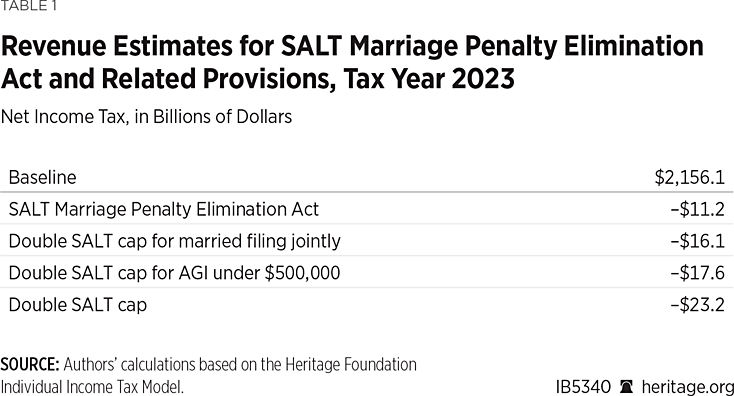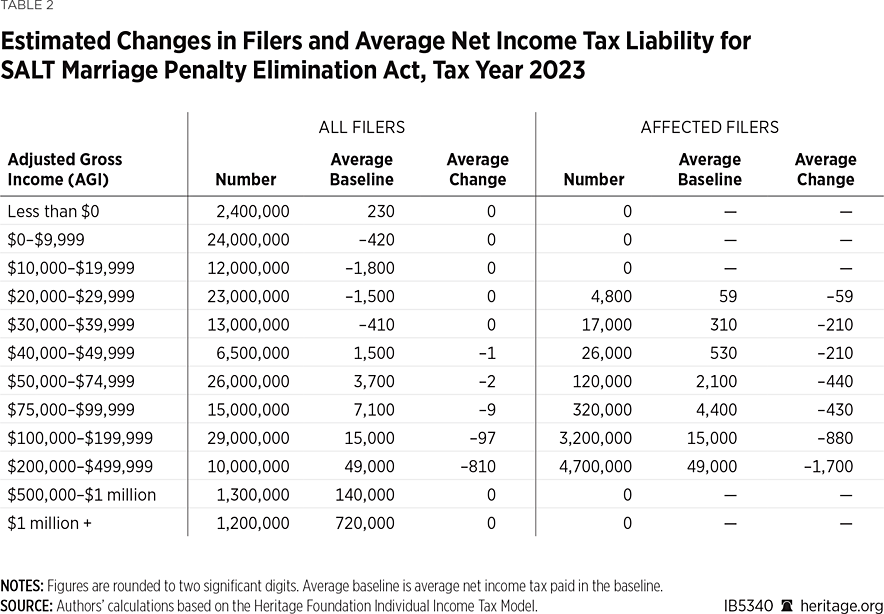H.R. 7160, the SALT Marriage Penalty Elimination Act (SMPEA), could come to a vote in the House of Representatives by February 9, having cleared the House Rules Committee by an 8-to-5 vote on February 1.
The legislation would double the cap on the state and local tax (SALT) deduction for married joint filers from $10,000 to $20,000 for the 2023 tax year only. The doubled cap would apply only to joint filers with adjusted gross income (AGI) of less than $500,000.
The policies in the bill would add to the deficit without affecting economic growth. While the bill only affects the most recent tax year, it sets a precedent that, if continued, would add to inflationary pressures through higher deficits. This Issue Brief presents estimates of the revenue effects of the bill, analyzes the policies, and describes the bill in legislative context.
Revenue Estimates
The SMPEA would reduce federal revenue by $11.2 billion in both fiscal year 2024 and across the 2024–2033 budget window. Table 1 shows the revenue estimates for the bill as written, along with variations of its provisions.

The increase in the allowable SALT deduction would make it more advantageous to itemize deductions under the SMPEA, so that about 3.2 million more filers would elect to itemize. This incentive would add to the number of hours that are devoted to preparing individual and family tax returns. More than half (1.7 million) of those new itemizers would have an AGI of greater than $200,000.

Whether it is better to take the standard deduction or to itemize deductions depends on a number of factors, including income. The likelihood that a filer claims the SALT deduction rises with income. Table 2 shows how the bill affects filers in different AGI ranges. Only 2 percent of filers with AGI below $100,000 would be affected. On the other hand, nearly 47 percent of filers with AGI between $200,000 and $500,000 would see a difference, with the average change being about a $1,700 net tax cut.
Analysis
The bill would have no effect on economic growth. The changes only apply to tax year 2023. Filers cannot go back in time and work more or save more in 2023 to take advantage of lower tax rates. The bill would also have no effect on marriage rates because it applies retroactively.
If the bill were renewed for the current or future tax years, it could discourage work in some cases. The bill would introduce a sharp cliff with high marginal tax rates, as going from $499,999 of AGI to $500,000 would lead married taxpayers to lose $10,000 of the SALT deduction and owe up to an additional $3,500 of tax.
The SALT deduction subsidizes high-tax states at the expense of residents in low-tax states. Because of the deduction, income is not taxed equally at the federal level. States can raise $10,000 of revenue with up to $3,700 coming from the federal government. The effective subsidy creates an incentive for states to set spending and tax burdens higher than they otherwise would.
The proper SALT deduction is $0. Eliminating the SALT deduction would tax residents of each state equally at the federal level. Taxpayers in high-tax states seeking lower tax bills should address their state legislatures, not Congress.
If the changes to the SALT deduction applied to future years, it would incentivize marriage, but only for a limited subset of taxpayers who are unlikely to be highly responsive to a modest financial incentive. If strengthening marriage is a major policy goal, as it should be, Congress should first eliminate the most egregious marriage penalties, which reside chiefly in the welfare system, not in tax provisions mostly affecting upper-middle-income taxpayers.
Policy History and Future
The implications of H.R. 7160 cannot be fully understood without the context of the major 2017 tax bill that created the SALT cap in the first place.
Prior to the 2017 Tax Cuts and Jobs Act (TCJA), taxpayers could claim many itemized deductions, which reduce their federal taxable income. Taxpayers who itemized their deductions could fully deduct the sum of their state and local property taxes, state and local real estate taxes, and either their state and local income taxes or sales taxes, whichever was higher.REF
The TCJA eliminated many individual itemized deductions and set a cap of $10,000 on the SALT deduction. It also almost doubled the standard deduction, which in 2023 was $13,850 for single taxpayers and $27,700 for married joint filers.REF The change both simplified the tax code and raised revenue to offset pro-growth tax cuts elsewhere in the tax law.
Since the TCJA took effect, the number of taxpayers who choose to itemize deductions has declined dramatically. Only about 9.3 percent of individual tax filers deducted some state and local taxes in 2020, the most recent year with data available.REF These taxpayers tend to be high-income taxpayers in states and localities with high income and property taxes.
H.R. 7160 sets a precedent for chipping away at a critical TCJA revenue raiser, despite only being in effect for tax year 2023. The precedent matters because TCJA’s SALT cap is set to expire at the end of 2025, the same time that most of the individual tax cuts sunset.
If, in 2025, Congress keeps the existing cap on the SALT deduction or eliminates the SALT deduction altogether, it would be able to extend more of the expiring tax cuts in a fiscally responsible way. If Congress instead raises or eliminates the SALT deduction cap in 2025, it is difficult to see the path to a fiscally responsible extension of the TCJA.
About the Estimates
The estimates were produced by a custom microsimulation model that was developed by The Heritage Foundation to analyze the individual income tax and reforms thereto.
The model starts with an IRS-produced sample of tax returns. For each observation in the sample, the program simulates the computation of taxes, similarly to software such as TurboTax. The IRS dataset is censored and missing values, thus the model imputes information as needed to estimate a tax filer’s net income tax.
The IRS does not release these datasets until seven years have passed. Thus, to study taxes over time, the model must generate a sequence of artificial samples to form the basis of tax return calculations beyond the original dataset year. This process (“evolution”) is governed by statistics such as the total number of households filing jointly and the sum of reported wages. For past years, these statistics are known, and for years hence, these statistics are forecasted.
The evolution process takes the original sample and modifies it, as conservatively as possible, such that it satisfies the specified statistics. The result is an artificial sample that captures observed or predicted trends while maintaining the heterogeneity present in the original sample.
The model then uses this artificial sample to calculate taxes for the sample’s year. The program cycles through these processes of evolution and tax calculation until it has simulated taxes for the 10-year budget window.
Preston Brashers is Research Fellow for Tax Policy in the Grover M. Hermann Center for the Federal Budget at The Heritage Foundation. Brian O’Quinn, PhD, is Senior Policy Analyst in, and Parker Sheppard, PhD, is Director of, the Center for Data Analysis at The Heritage Foundation.






